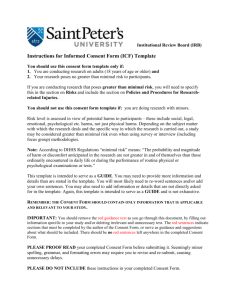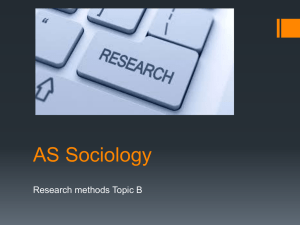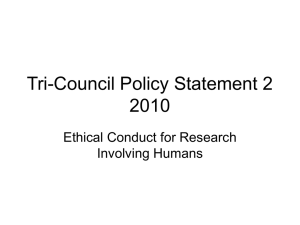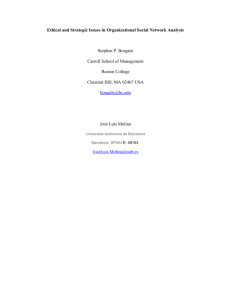Ethics
advertisement
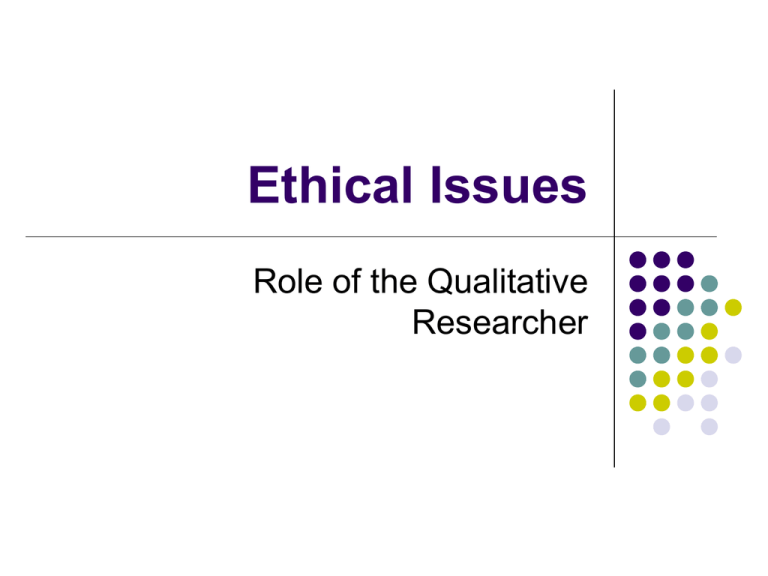
Ethical Issues Role of the Qualitative Researcher Basic Assumptions about How Research Should be Conducted Subjects should be protected from harm. Subjects should have their identity protected. Subjects should be fully informed about the research study. Participation is voluntary. Study procedures should show respect for cultural values and beliefs. Some studies can potentially harm participants. Consequently risks should be minimized. Potential harm can include: Pain or physical danger. Emotional arousal or stress Observation or release of findings can cause embarrassment or social distress. Observation can involve misinformation or deception. Participant observation techniques should be used cautiously. In order to make sure that participants are protected, all studies must be reviewed by human subjects/ethics review committee. Your projects must be reviewed by: The agency in which your study will be conducted. DSWE Human Subjects Committee In rare cases, the University Human Subjects Committee may be asked to review your study if the department committee thinks that participants may be potentially harmed. Except for observation in public settings, Participants must give consent to participate. We are especially concerned about: Children under 18 (consent must be obtained from parents). Involuntary clients Any participants likely to be vulnerable to coercion or undue influence. Components of Informed Consent Include: Accurate explanation of evaluation procedures is made. Respondent is given an explanation of risks and benefits An offer is made to answer any additional questions about the project (contact information must be included) The participant is told that he or she can withdraw at any time. Steps must be taken to protect participants from harm: Confidentiality must be protected. We must not identify people who participate in the study. If the study is likely to cause emotional arousal, we must make provisions to refer participants to a mental health professional for counseling. Methods for Protecting Confidentiality Include: Responses must be anonymous (as feasible). All information that can be attributed to individuals is kept confidential. Fictional names are often used in qualitative analysis or code numbers are assigned to individuals for conducting the analysis. Respondents may be referred to using terms that do not indicate name/characteristics of individuals such as “respondent” or “participant”). In small samples, care should be taken not to reveal much about personal characteristics of respondents such as ethnicity or job title if it would help readers identify individual respondents. A coding system can be used to track returned surveys or case records. However, the coding system should be kept in a secured location separate from the responses. The responses are also kept in a secure location; only the researcher will have access. Any instruments that could identify a respondent should be destroyed after data analysis if it can not be kept in a secure location. This includes tape recordings. Information about individual respondents should not be shared with agencies or supervisors. Methods used to verify consent to participate Return of surveys implies consent (surveys should be distributed with letters that contains information about the study and human subjects protections). Participation in phone interview implies consent. Signed consent forms from participants (in some cases it may be sufficient to provide verbal information). IMPORTANT!!! Consent forms are needed for all research-related interviews other than interviews with public officials. No consent forms are needed for brief interviews in public settings Public behavior (observations) generally does not require consent. Cover letters and consent forms should contain the following information: A description of the purpose of the study. An explanation as to how participants were selected. A statement that participation is voluntary and that participants may withdraw at any time. A description about procedures and what will be required from participants. Emotionally sensitive issues that might be exposed and/or follow-up resources that are available if required. A description of how information will be recorded if videotaping or audiotape is required. A description of any discomforts and any known risks. An explanation of who will have access to the data and information about the identity of respondents. A description of how the data will be made public or of any other persons who may make use of the data Contact information (for the researcher or the researcher’s institution) if the participant has any questions. Additional human subjects issues Payment for participation (o.k. if everyone is paid). Case record analysis requires that steps be taken to protect confidentiality of subjects and people described in the case record. Deception. (May be used in some cases where it will not cause undo harm or when authorities have been given permission). Ethical Issues in Qualitative Research Researchers must state values and biases in writing reports. Researchers must take steps to ensure that accurate accounts of participant perceptions are written Researchers have a responsibility to use the data to enhance social change. Consent is sometimes obtained through personal interaction with individuals or communities (entry). The researcher must establish trusting relationships. Participants may be viewed as partners in the research process and always as the social equal of the researcher. Establishing accuracy of data is called trustworthiness. Rather than reliability and validity of instruments, in qualitative research we talk about whether the research is trustworthy. Padgett defines “trustworthy” studies as those that are ethical and fair and that portray respondents experiences and perceptions accurately. Assumption is that the researcher is the instrument and that the observation or interview is “filtered through” the researcher and the researcher writes up the findings. Primary Trustworthiness Concerns Reactivity (Hawthorne Effect) – have people reacted to being studied. Researcher biases, own values/perceptions or becoming too close or two distant from respondents. Respondent biases – may lie or be to helpful Procedures for establishing trustworthiness Obtaining feedback on written results from respondents. Prolonged engagement (observational studies or interviews conducted over a long period of time) Member checking – asking respondents for feedback on data analysis and coding Triangulation using several data sources (for example, both interviews and observation) or more than one observer. Peer debriefing and support Negative case analysis Audit trail Cultural Competency Check to make sure that subjects can understand concepts described in survey or interview guide (pre-test). Are terms used that may have different meanings in different cultures. Is the level of language appropriate to the participants? Translations should be checked for accuracy and appropriateness of language to social class, age, and other demographic characteristics of participants (for example, formal versus informal Spanish). Do study procedures violate any cultural norms (check with an informed source in the community). Other qualitative issues: Boundaries (appropriate amounts of involvement vs. social distance) Keeping records of one’s own reactions as part of the research process – don’t interject them into the setting though. Protect confidentiality except in situations involvement immediate harm. Make sure to take precautions to protect one’s self. Need to be able to establish relationships with respondents (engagement skills). Need to be flexible – especially during the data collection process and open to new things and ways of understanding them. Re: Moral dilemmas – Reporting negative behavior (from Padgett): Sometimes our respondents are involved in activities that are not dangerous, but are still illegal, for example, shoplifting, prostitution, drug use, or truancy from school. Qualitative researchers cannot allow their personal or moral concerns about these behaviors to interfere with the promise of confidentiality (p. 39). For reporting abuse, Padgett suggests that the researcher consider whether It is necessary or beneficial to report when data is being collected. It may be sufficient to use the findings to engage in social action after the final report is written. DSWE requirements for human subjects review Submit pink human subjects forms to 292 instructor for the review process. Submit your methodology chapter. Submit a copy of your research instrument. Submit a copy of cover letters and consent forms. For secondary analysis, provide a detailed description of the data base to be used and how the data was originally obtained. (See human subjects procedures on course web page or department Blackboard).




